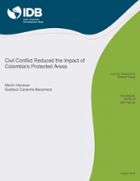Civil Conflict Reduced the Impact of Colombia's Protected Areas
Date
Aug 2018
Protected areas are fundamental to reaching the goals laid out as a part of the recent Sustainable Development Goals. Recognition of the importance of protected areas from policy makers, practitioners, and academics alike has led to increased interest in evaluating the effectiveness of this conservation instrument. Colombia is a particularly interesting setting in which to study the effects of protected areas. Colombia is one of the most biodiverse countries in the world and has a large network of protected areas. Importantly, during the decades that the protected area network was being developed, Colombia also saw the unique and marked rise of guerrilla activity (domestic terrorism). In addition to negative social outcomes, guerrilla activity also has led to increases in deforestation; and although evidence shows that Colombia's protected areas have achieved modest reductions in deforestation, further evidence suggests that protected areas have facilitated guerrilla activities. We use quasi-experimental methods to (1) estimate the average impact of Colombia's protected areas established prior to 2002 on forest cover (1990-2010) and poverty (1993-2005), and (2) decompose those average effects into those that are attributable to protected areas' effect of guerrilla activities (mechanism effect) and those that are net the mechanism effects (the direct effect). We find that, on average, protected areas had no statistically signicant impact of either outcome. However, we find that, had protected areas not also increased guerrilla activities, reductions in deforestation would have been over twice as large and statistically signicant, and the poverty reducing effects would have been over three times as large.




